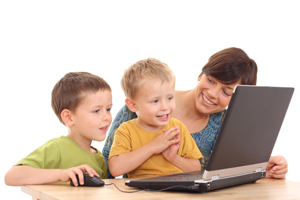Creation and Implementation
I recently sat down to a great phone chat with co-creator of Signing Time, Emilie Brown, and also listened to a radio interview Rachel Coleman did, to learn more about the creation of Potty Time. You can read the back-story to Signing Time HERE and the first installment of the interview with Emilie HERE.
What was the creation of Potty Time like?
As we talked about in PART TWO of this series, from the very beginning of Signing Time (even from year one!) many requests for a potty training show were rolling in. But Rachel freely admits that she felt resistant to teaching signs for bathroom words and singing about bathroom words.
However, once Rachel and Emilie realized there was a big need for a potty training approach that taught kids about their amazing bodies, and how they needed to listen to those bodies, Potty Time production was up and running.
 The creative process of writing “Look at you Grow” and “Your Body is Amazing” were easy for Rachel. But she still just did not want to write a potty song! So, the obvious answer was to pass on the job to their youngest brother, Aaron (who incidentally is in on the family business and helps with music production and sound design.)
The creative process of writing “Look at you Grow” and “Your Body is Amazing” were easy for Rachel. But she still just did not want to write a potty song! So, the obvious answer was to pass on the job to their youngest brother, Aaron (who incidentally is in on the family business and helps with music production and sound design.)
So Aaron is responsible for “Uh-oh, It’s an Accident” and “The Potty Dance”, writing the potty songs as only a little brother can do (and we are very glad he did!).
You can listen to a radio interview with Rachel on the creation of Potty Time HERE.
How do you see Potty Time being used at home?
I asked Emilie what their vision was for Potty Time once it was created. How would families from all walks of life use it? The first hope of course was that families would start watching the video, using the signs, and integrating it into their potty training routines.
More than that though, the hope was that every family would have the support they need to have potty training be a great experience – with whatever method they choose – with a tool to help kids be excited about potty training and be successful in that process.
What about using Potty Time in childcare settings?
To the Signing Time folks, the most effective trainers are the parents because they can be the models. It’s a challenge for someone who is not the parent to be able to navigate something like potty training. If they are using Potty Time, that framework of positive messages and support can really help them be aware of the important messages that kids need.
 In daycare, there are often kids of all ages and developmental stages, so signing in general can be critical and very helpful. In addition, if the daycare uses media (like videos), Potty Time can make a difference for their kids more so than some shows that are purely for entertainment.
In daycare, there are often kids of all ages and developmental stages, so signing in general can be critical and very helpful. In addition, if the daycare uses media (like videos), Potty Time can make a difference for their kids more so than some shows that are purely for entertainment.
When it comes to preschools, most children are expected to be potty trained when they enroll. But this video isn’t just for kids who are starting to train. Even after potty training is more or less complete, you still have to deal with some of those bathroom things… like remembering to wash hands all the time! In this case, Potty Time can be an ongoing support to help newly potty-trained kids in a new environment.
Finally, it is Potty Time, after all! Let’s keep our sense of humor!
Just for fun, I asked Emilie if she had any funny stories to tell about the creation process. She had a few!
During production there were some pretty funny conversations about the products that would be used with Potty Time. The creation of these products is literally a fine art. So when something like the pee spot Hopkins makes in the board book isn’t quite the “right” yellow, a conversation has to happen. You can imagine the laughter from the illustrators, who probably weren’t quite accustomed to these sorts of… details in their work!
After Potty Time was created, the team hosted a preview party for all the kids who were involved in the show. There is a song in the video called “Stop and Go” (to the bathroom), and by the end of the song, half the young audience was all lined up to go to the bathroom. Proof that the concept works, I guess!
In Conclusion
I hope you’ve enjoyed this behind the scenes look at Potty Time creation and all the love and effort that went into the production process.
As Emilie said, “Who knew that potty training could be so fun and tender? And that potty training could be another opportunity to strengthen the relationship between parents and their kids?”
That, in essence, is the Potty Time goal.

